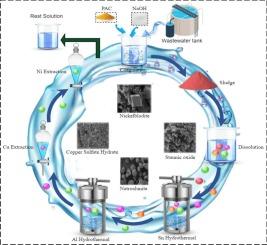New insights into coagulation-enrichment and hydrometallurgical recovery of Sn, Cu, Ni from electroplating wastewater
IF 6.7
2区 工程技术
Q1 ENGINEERING, CHEMICAL
引用次数: 0
Abstract
The tin plating industry is widely utilized in steel rolling and furniture manufacturing industries, employing tin-containing agents for electroplating. This process inevitably discharges electroplating wastewater. Such wastewater was rich in heavy metals and poses serious environmental hazards. The recovery of heavy metals from the wastewater was of research in recent decades. Herein, a novel strategy was developed to recover Tin (Sn), Copper (Cu) and Nickel (Ni) from the wastewater via a combined coagulation and hydrometallurgy route. The wastewater contained 397 mg/L tin, 85 mg/L copper and 31 mg/L nickel, and was coagulated by adding a high dosage of 300 mg/L polyaluminium chloride (PAC). After that, Tin, Copper, Nickel were enriched in the generated sludge, and then completely leachate into mixed nitric and hydrochloric acid. The acid leachate was treated by a two-step hydrothermal route with the addition of glucose/nitrate, to firstly crystallized 99.23 % tin as cassiterite particles (contained 98.5 % Tin), and then to precipitate 97.31 % aluminum as natroalunite sphere (contained 99.2 % aluminum), with the loss of copper/nickel <4 %. The thermodynamic analysis showed that the hydrolysis of tin as cassiterite spontaneous started at 120 °C at pH 0.3, and that of aluminum as natroalunite also occurred in the presence of sulfate, but these of copper/nickel did not occur at pH < 0.7. After that, the resulting leachate was extracted by using Acorga M5640 and HBL110, respectively, to separate 91.9 % copper as copper sulfate hydrate and 93.6 % nickel as nickelblodite. This proposed a practical strategy for the enrichment and recovery of heavy metals from wastewater.

电镀废水中锡、铜、镍的混凝富集及湿法冶金回收新进展
镀锡行业广泛应用于轧钢和家具制造行业,采用含锡剂进行电镀。这一过程不可避免地会产生电镀废水。废水中重金属含量高,环境危害严重。从废水中回收重金属是近几十年来的研究热点。在此基础上,提出了一种采用混凝和湿法冶金相结合的方法从废水中回收锡、铜、镍的新策略。废水中锡含量为397 mg/L,铜含量为85 mg/L,镍含量为31 mg/L,采用高剂量300 mg/L聚合氯化铝(PAC)进行混凝。之后,锡、铜、镍在生成的污泥中富集,然后完全浸出到硝酸和盐酸中。采用葡萄糖/硝酸盐两步水热法处理酸性渗滤液,先将99.23%的锡结晶为锡石颗粒(含锡98.5%),再将97.31%的铝沉淀为钠矾石球(含铝99.2%),铜/镍损失4%。热力学分析表明,锡锡石的水解始于120℃,pH = 0.3,铝钠矾石的水解也发生在硫酸盐的存在下,而铜/镍的水解在pH = lt下没有发生;0.7. 之后,用Acorga M5640和HBL110分别对所得渗滤液进行萃取,分离出91.9%的铜为水合硫酸铜,93.6%的镍为镍blodite。这为废水中重金属的富集和回收提供了一种实用的策略。
本文章由计算机程序翻译,如有差异,请以英文原文为准。
求助全文
约1分钟内获得全文
求助全文
来源期刊

Journal of water process engineering
Biochemistry, Genetics and Molecular Biology-Biotechnology
CiteScore
10.70
自引率
8.60%
发文量
846
审稿时长
24 days
期刊介绍:
The Journal of Water Process Engineering aims to publish refereed, high-quality research papers with significant novelty and impact in all areas of the engineering of water and wastewater processing . Papers on advanced and novel treatment processes and technologies are particularly welcome. The Journal considers papers in areas such as nanotechnology and biotechnology applications in water, novel oxidation and separation processes, membrane processes (except those for desalination) , catalytic processes for the removal of water contaminants, sustainable processes, water reuse and recycling, water use and wastewater minimization, integrated/hybrid technology, process modeling of water treatment and novel treatment processes. Submissions on the subject of adsorbents, including standard measurements of adsorption kinetics and equilibrium will only be considered if there is a genuine case for novelty and contribution, for example highly novel, sustainable adsorbents and their use: papers on activated carbon-type materials derived from natural matter, or surfactant-modified clays and related minerals, would not fulfil this criterion. The Journal particularly welcomes contributions involving environmentally, economically and socially sustainable technology for water treatment, including those which are energy-efficient, with minimal or no chemical consumption, and capable of water recycling and reuse that minimizes the direct disposal of wastewater to the aquatic environment. Papers that describe novel ideas for solving issues related to water quality and availability are also welcome, as are those that show the transfer of techniques from other disciplines. The Journal will consider papers dealing with processes for various water matrices including drinking water (except desalination), domestic, urban and industrial wastewaters, in addition to their residues. It is expected that the journal will be of particular relevance to chemical and process engineers working in the field. The Journal welcomes Full Text papers, Short Communications, State-of-the-Art Reviews and Letters to Editors and Case Studies
 求助内容:
求助内容: 应助结果提醒方式:
应助结果提醒方式:


